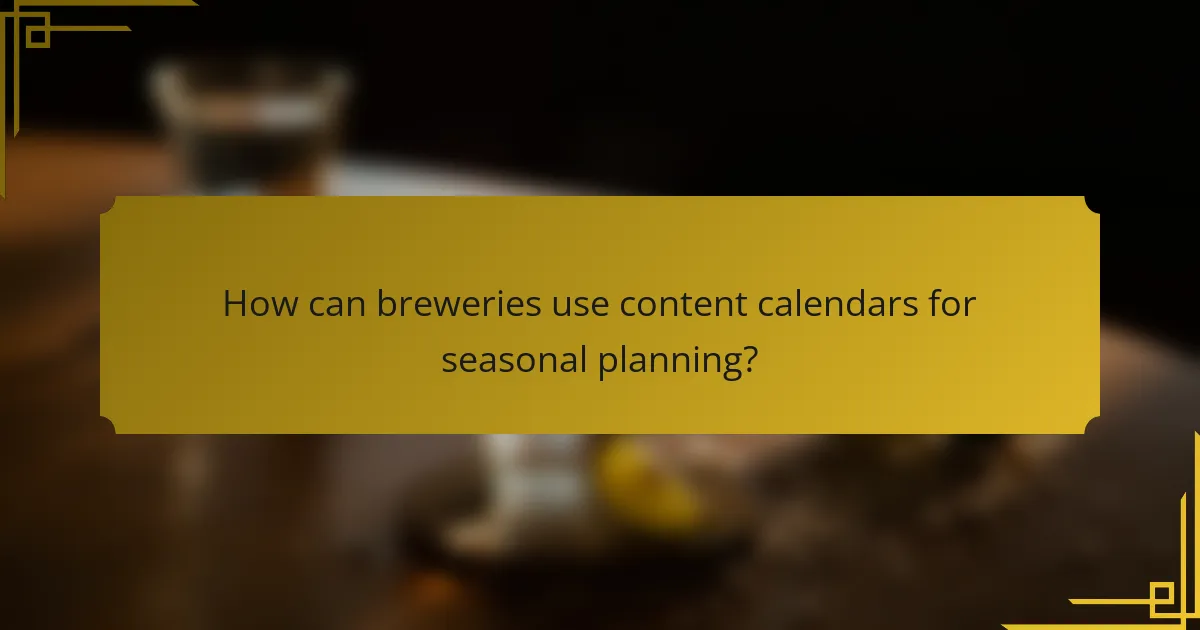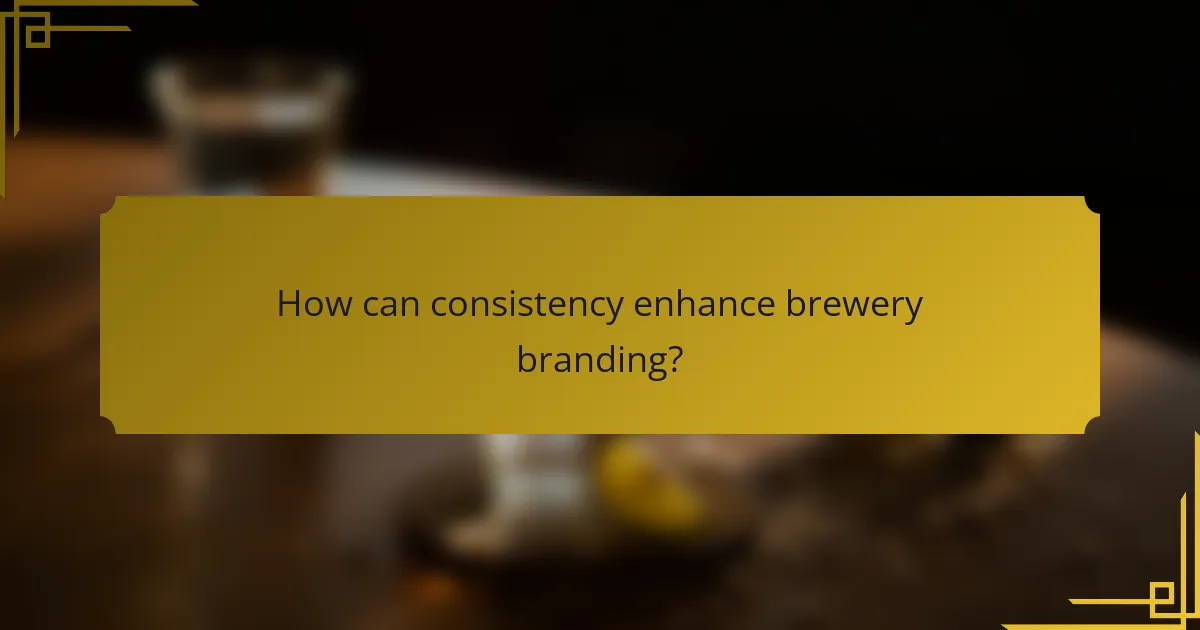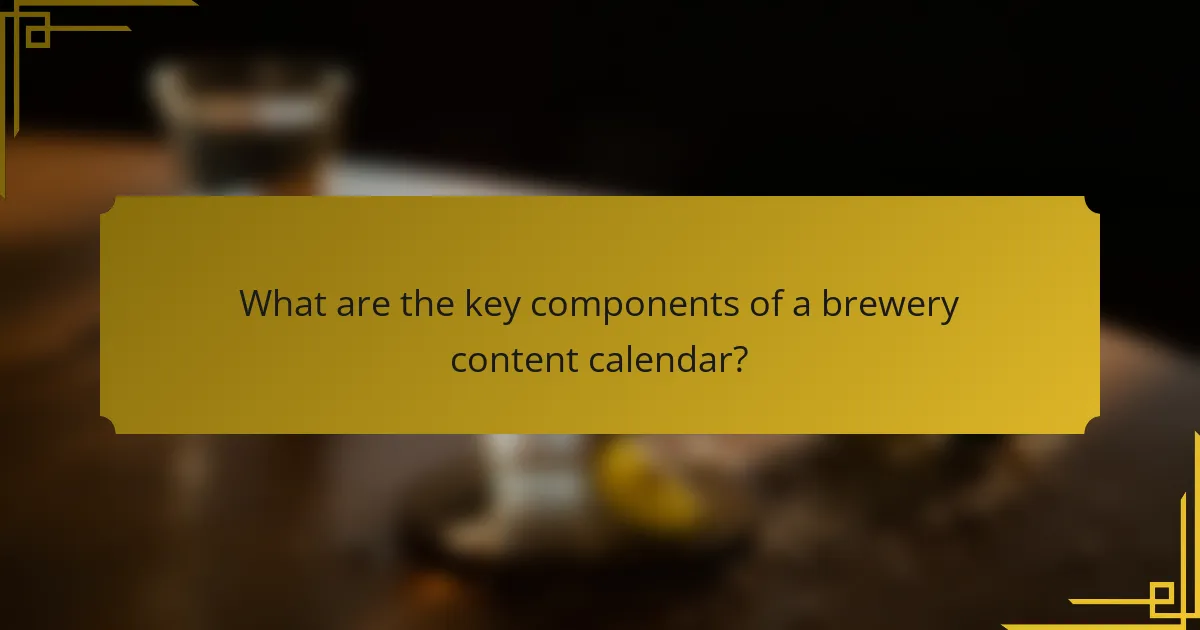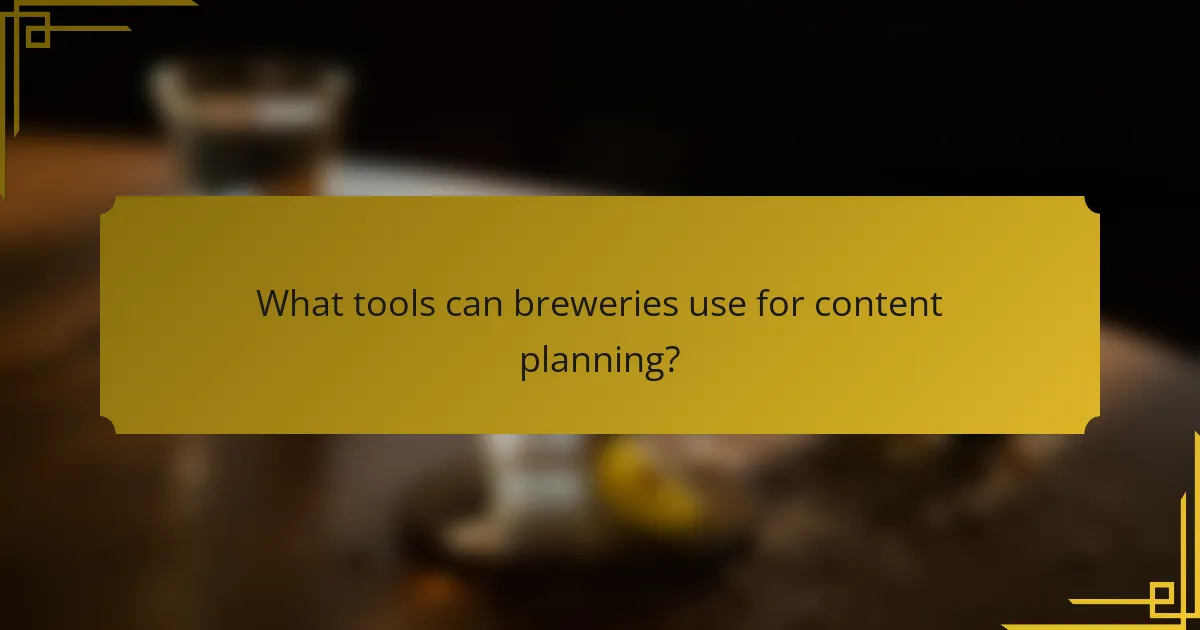Brewery content calendars are vital for synchronizing marketing initiatives with seasonal trends and enhancing customer engagement. By strategically planning content around seasonal themes, breweries can effectively showcase their offerings and connect with their audience at optimal times, fostering brand loyalty and community. Consistency in branding across platforms further solidifies recognition and strengthens customer relationships.

How can breweries use content calendars for seasonal planning?
Brewery content calendars are essential tools for aligning marketing efforts with seasonal trends and customer engagement. By planning content around seasonal themes, breweries can effectively promote their products and connect with their audience at the right moments.
Aligning content with seasonal beer releases
To maximize impact, breweries should schedule content that coincides with seasonal beer releases. For example, launching a pumpkin ale in the fall can be paired with social media posts highlighting the beer’s unique flavors and brewing process. This alignment not only builds anticipation but also encourages customers to visit the brewery or purchase the beer when it becomes available.
Consider creating a timeline that outlines key release dates and corresponding content, ensuring that promotional efforts are timely and relevant. This can include blog posts, videos, or even behind-the-scenes looks at the brewing process.
Planning events around local festivals
Local festivals present excellent opportunities for breweries to engage with the community and promote their brand. By planning events or special promotions that coincide with these festivals, breweries can attract more visitors and enhance their visibility. For instance, hosting a beer tasting during a local harvest festival can draw in festival-goers looking to explore local flavors.
It’s beneficial to research local festivals well in advance and incorporate them into the content calendar. This proactive approach allows breweries to prepare marketing materials, coordinate with event organizers, and ensure they have enough inventory to meet increased demand.
Creating themed promotions for holidays
Themed promotions around holidays can significantly boost customer engagement and sales. Breweries can create special beers or offer discounts during holidays such as Christmas, Halloween, or Independence Day. For example, a brewery might release a limited-edition stout for St. Patrick’s Day, accompanied by festive social media campaigns.
When planning these promotions, consider the target audience and tailor the messaging to resonate with holiday themes. Engaging visuals and compelling narratives can enhance the effectiveness of these campaigns, making them more memorable for customers.
Utilizing weather trends for marketing
Weather can greatly influence consumer behavior, and breweries can leverage this by adjusting their marketing strategies accordingly. For instance, promoting refreshing lagers and wheat beers during hot summer months can attract thirsty customers. Conversely, rich stouts and porters may be more appealing during colder seasons.
Monitoring weather forecasts and historical trends can help breweries anticipate customer preferences. Consider using this data to inform social media posts, email newsletters, and in-store promotions, ensuring that marketing efforts align with current weather conditions.

What are effective strategies for audience engagement?
Effective strategies for audience engagement in a brewery context include leveraging social media, implementing email marketing, hosting interactive events, and encouraging user-generated content. These approaches help build a community around your brand and foster loyalty among customers.
Leveraging social media campaigns
Social media campaigns are a powerful tool for engaging your audience. Platforms like Instagram and Facebook allow breweries to showcase new releases, share behind-the-scenes content, and connect with customers in real-time. Regularly posting engaging content can increase brand visibility and encourage interaction.
Consider running targeted ads or promotions to reach specific demographics, especially during seasonal events or holidays. Engaging with followers through polls, questions, and contests can also enhance community involvement and drive traffic to your brewery.
Implementing email marketing for updates
Email marketing is an effective way to keep your audience informed about new products, events, and promotions. Building a subscriber list allows you to send tailored messages directly to your customers, increasing the likelihood of engagement. Aim for a consistent schedule, such as monthly newsletters, to maintain interest.
Include exclusive offers or early access to events in your emails to incentivize sign-ups. Ensure your emails are visually appealing and mobile-friendly, as many users check their emails on smartphones. Monitor open and click-through rates to refine your strategy over time.
Hosting interactive brewery events
Hosting interactive events at your brewery can significantly enhance audience engagement. Consider organizing tastings, brewery tours, or themed nights that encourage customer participation. These events not only attract new visitors but also create memorable experiences that foster loyalty.
Promote these events through your social media channels and email newsletters. Collaborating with local musicians or food vendors can also add value and draw larger crowds. Ensure you have a clear plan for managing attendance and safety, especially during peak seasons.
Encouraging user-generated content
Encouraging user-generated content (UGC) is an effective way to engage your audience and build community. Ask customers to share their experiences with your products on social media using a specific hashtag. This not only provides authentic content but also allows you to showcase your customers’ loyalty.
Consider running contests or featuring UGC on your official channels to motivate participation. Highlighting customer stories or photos can create a sense of belonging and encourage others to contribute. Always give credit to the original creators to foster goodwill and strengthen relationships.

How can consistency enhance brewery branding?
Consistency in brewery branding strengthens recognition and fosters customer loyalty. By maintaining a uniform approach across various platforms, breweries can create a memorable identity that resonates with their audience.
Maintaining a regular posting schedule
A regular posting schedule keeps your audience engaged and informed about your brewery’s offerings. Aim to post at least once a week on social media and update your website monthly to keep content fresh and relevant.
Consider using a content calendar to plan your posts around seasonal events, beer releases, and local festivals. This ensures that your audience knows when to expect new content, enhancing their connection to your brand.
Creating a cohesive visual identity
A cohesive visual identity includes consistent use of colors, fonts, and imagery across all marketing materials. This visual consistency helps customers instantly recognize your brand, whether they see a social media post, a label, or a promotional flyer.
To achieve this, develop brand guidelines that outline your visual elements and apply them uniformly. For example, use the same color palette and logo placement on your website and social media profiles to create a unified look.
Establishing brand voice across platforms
Your brand voice should reflect your brewery’s personality and values, whether it’s playful, sophisticated, or community-focused. Consistency in tone helps build trust and familiarity with your audience.
Define your brand voice and ensure it is applied across all communication channels, including social media, newsletters, and customer interactions. For instance, if your brand voice is casual and friendly, use informal language and humor in your posts to engage your audience effectively.

What are the key components of a brewery content calendar?
A brewery content calendar is a strategic tool that outlines the timing and type of content to be shared with audiences. Key components include identifying target audience segments, setting measurable goals, and integrating both promotional and educational content to enhance engagement and consistency.
Identifying target audience segments
Understanding your target audience is crucial for effective content planning. Segment your audience based on demographics, preferences, and behaviors, such as craft beer enthusiasts, casual drinkers, or local community members. This allows you to tailor content that resonates with each group.
Consider using surveys or social media insights to gather data on your audience. For example, if a significant portion of your audience is interested in local events, focus content around brewery tours or community festivals. This targeted approach increases engagement and fosters loyalty.
Setting measurable goals for content
Establishing measurable goals helps track the effectiveness of your content strategy. Goals can include increasing social media followers, boosting event attendance, or enhancing website traffic. Aim for specific targets, such as a 20% increase in engagement over a quarter.
Utilize analytics tools to monitor progress toward these goals. Regularly review performance metrics and adjust your content calendar as needed to ensure alignment with your objectives. For instance, if a particular post type drives more traffic, consider increasing its frequency.
Integrating promotional and educational content
Balancing promotional and educational content is essential for maintaining audience interest. Promotional content can include announcements about new beer releases or special events, while educational content might cover brewing techniques or beer pairings. Aim for a ratio of about 70% educational to 30% promotional to keep your audience engaged.
Incorporate various formats, such as blog posts, videos, and social media updates, to diversify your content. For example, a video series on the brewing process can educate viewers while subtly promoting your brand. This approach not only informs but also builds a community around your brewery.

What tools can breweries use for content planning?
Brewery content planning can be effectively managed using a variety of tools designed to streamline scheduling, collaboration, and audience engagement. These tools help breweries maintain consistency in their messaging and adapt to seasonal trends.
Content Calendars
Content calendars are essential for breweries to organize and visualize their marketing efforts over time. They allow teams to plan campaigns around seasonal events, product launches, and holidays, ensuring timely and relevant content. A well-structured calendar can include key dates, themes, and promotional activities.
Breweries can use digital tools like Google Calendar, Trello, or Asana to create and share their content calendars. This promotes collaboration among team members and keeps everyone aligned on upcoming tasks and deadlines.
Social Media Management Tools
Social media management tools help breweries schedule posts, track engagement, and analyze performance across platforms. Tools like Hootsuite, Buffer, and Sprout Social allow breweries to plan their social media content in advance, ensuring a consistent online presence.
These tools often include analytics features that provide insights into audience behavior, helping breweries refine their strategies. By understanding what content resonates with their audience, breweries can tailor their messaging to increase engagement and reach.
Email Marketing Platforms
Email marketing platforms are crucial for breweries to communicate directly with their customers. Tools like Mailchimp or Constant Contact enable breweries to create targeted email campaigns, share news, and promote events or new releases.
Effective email marketing requires segmenting the audience based on preferences or behaviors, allowing for personalized messaging. Regular newsletters can keep customers informed and engaged, fostering loyalty and repeat visits.
Analytics and Reporting Tools
Analytics and reporting tools are vital for breweries to measure the effectiveness of their content strategies. Platforms like Google Analytics and Facebook Insights provide data on website traffic, user engagement, and social media performance.
By analyzing this data, breweries can identify trends and adjust their content planning accordingly. Regularly reviewing analytics helps breweries understand what works and what doesn’t, allowing for continuous improvement in their marketing efforts.
